Discovery of R-DLA
R-DLA is the abbreviation for R-dihydrolipoic acid. R-DLA is made naturally by all animals and humans. There are two forms of lipoic acid present in each cell, which are called R-dihydrolipoic acid and alpha lipoic acid; cells of the body can convert one into the other. Alpha lipoic acid was the first one to be isolated in 1951; it was first recognized by Snell in 1937 and was isolated in pure form by Reed in1951 (1).

It was given this name because it was the alpha or first substance of its kind to be chemically identified, was found to dissolve in fat (lipoic) and was an acidic substance. At first, obtaining enough lipoic acid for research was very difficult as scientists of the 1950s and 60s were only able to isolate 30mg of lipoic acid from 10 tons of cow’s liver, indicating that cells only produce a very small amount of this substance. (2)
During the 1980s, lipoic acid was revealed to be a powerful antioxidant (2). In the late 1990s alpha lipoic acid was first introduced as a supplement.
Soon after it became clear that R dihydrolipoic acid, which is the reduced form of lipoic acid, was the natural, biologically active form of lipoic acid that provides the bulk of the biological antioxidant protection. R dihydrolipoic acid is able to provide a greater level of antioxidant protection because each molecule of R dihydrolipoic acid contains two additional electrons that alpha lipoic acid does not have.

It was given this name because it was the alpha or first substance of its kind to be chemically identified, was found to dissolve in fat (lipoic) and was an acidic substance. At first, obtaining enough lipoic acid for research was very difficult as scientists of the 1950s and 60s were only able to isolate 30mg of lipoic acid from 10 tons of cow’s liver, indicating that cells only produce a very small amount of this substance. (2) During the 1980s, lipoic acid was revealed to be a powerful antioxidant (2). In the late 1990s alpha lipoic acid was first introduced as a supplement.
Soon after it became clear that R dihydrolipoic acid, which is the reduced form of lipoic acid, was the natural, biologically active form of lipoic acid that provides the bulk of the biological antioxidant protection. R dihydrolipoic acid is able to provide a greater level of antioxidant protection because each molecule of R dihydrolipoic acid contains two additional electrons that alpha lipoic acid does not have.
Electrons are critical for neutralizing reactive oxygen species in the body and fighting against oxidative stress. Because R-dihydrolipoic acid has these additional electrons it is the only form of lipoic acid that is effective against superoxide and peroxyl reactive oxygen species (3). This is critical for antioxidant protection because superoxide is the source of most of the highly damaging hydrogen peroxide produced in cells.
Redox Bioscience has developed a patent-pending process for making R-dihydrolipoic acid of 99% purity in order to optimize its natural biological antioxidant capability.
- Liguori I, Russo G, Curcio F, Bulli G, Aran L, Della-Morte D, Gargiulo G, Testa G, Cacciatore F, Bonaduce D, Abete P. Oxidative stress, aging, and diseases. Clinical interventions in aging. 2018 Apr 26:757-72.
- Pizzino G, Irrera N, Cucinotta M, Pallio G, Mannino F, Arcoraci V, Squadrito F, Altavilla D, Bitto A. Oxidative stress: harms and benefits for human health. Oxidative medicine and cellular longevity. 2017 Oct;2017.

